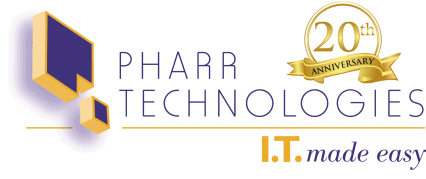IT security is essential for any business looking to make business processes more efficient, particularly as their communication needs grow. The right infrastructure can help you streamline workflows and maintain seamless operations across departments while protecting sensitive information.
This is where Pharr Technologies can help. Our experienced staff can help you identify and mitigate all types of IT security risks, including those most commonly seen when using IoT devices and networks. We’ll cover major security challenges companies face, from data privacy to standardization.
IoT Risks
While the Internet of Things (IoT) provides businesses with unmatched convenience and innovation, it also comes with its own risks. Potential security issues can include:
Insufficient Security Protocols
IoT devices are cost-effective and easy to use, but they also require sufficient security. Without the right security features, these devices could be susceptible to cyber threats, including system hacks resulting from weak default passwords and inadequate encryption.
Unpatched Software
A surprisingly large number of malware issues are traced back to known vulnerabilities. Outdated software and firmware can leave systems vulnerable to distributed denial-of-service (DDoS) attacks, ransomware attacks, and other cyber threats.
Data Privacy Issues
Without sufficient privacy measures in place, IoT users cannot easily track the type and scope of data collected. Other parties may try accessing that data without the company’s permission. If multiple IoT devices are vulnerable to attacks, hackers can use botnets to steal their data.
Physical Security Concerns
Door locks, thermostats, and other IoT devices can be accessed by unauthorized parties who can quickly change their settings, potentially compromising safety and a facility’s environmental conditions.
Lack of Standardization
If a facility has a large number of IoT devices and networks, it can be difficult to standardize security across all of them. This leaves more room for internal or external sources to misuse or expose your data.
How IoT Device Vulnerabilities Affect Users
With the increasing use of IoT solutions, even the simplest of devices can impact overall security. This vulnerability could negatively affect users in a number of ways:
Privacy Invasion
IoT device vulnerabilities can impact privacy through:
- Data collection. IoT devices frequently collect different types of data, including user preferences, usage trends, and, in some cases, physical movement. If this data isn’t secure, malicious parties could access it for everything from ad targeting to data or identity theft.
- Mic and camera hacks. Many IoT devices also have cameras and microphones that could allow for unauthorized audiovisual surveillance, including baby monitors, security camera networks, and speakers.
Security Threats
Security threats to IoT devices can include:
- Botnet recruitment. Hackers could connect multiple compromised IoT devices into a collective botnet under their control, allowing them to commit attacks across the entire network and causing issues with functionality and performance, potentially rendering them entirely unusable or inaccessible.
- Network infiltration. Even a single compromised device could give external sources unauthorized access to your entire network, allowing them to steal sensitive data or inject malware into your system. Hackers could also gain control of various smart devices in the home, such as thermostats and door locks.
Strategies to Secure IoT Devices and Networks
Securing smart devices and networks often means tackling security challenges from multiple angles. Some key strategies companies can benefit from implementing include:
- Opting for devices with sufficient security. Choose devices with security features such as strong password protection, secure encryption, and regular firmware and software updates.
- Choosing strong passwords. Simple passwords can make your profile or account an easy target for hackers. A strong password should include a combination of numbers, letters, and symbols. It should also be unique to your device.
- Allowing two-factor authentication. If your device supports it, opt for two-factor authentication. This will require users to confirm their identity on two different platforms before they can gain access to a given device.
- Regularly updating software. As soon as manufacturers release software or firmware updates, be sure to install them and keep them up to date. This way, your device is utilizing the most recent (and advanced) security features.
- Segmenting networks. Separating IoT networks via a digital barrier makes it harder for hackers to access information across networks. Segmenting networks can also improve the performance of your IoT devices by preventing network congestion.
- Implementing a strong firewall. A good firewall will regulate all traffic passing through the network while notifying administrators of suspicious network activity.
- Disabling unused features. If a device collects data you don’t need, disable these features to ensure that devices only collect relevant data for increased security.
- Researching available solutions. Look into each device’s security features and the manufacturer before buying. A reliable manufacturer will be able to effectively demonstrate the security of their solution.
Navigating Security Challenges in the IoT Era With Pharr Technologies
Want to maximize your IoT security? Pharr Technologies provides comprehensive cybersecurity solutions that protect digital assets and streamline operations across your larger network systems.
Contact us today to learn more about our solutions and what they can do for you. You can also request a quote for a custom security solution.


Comments are closed